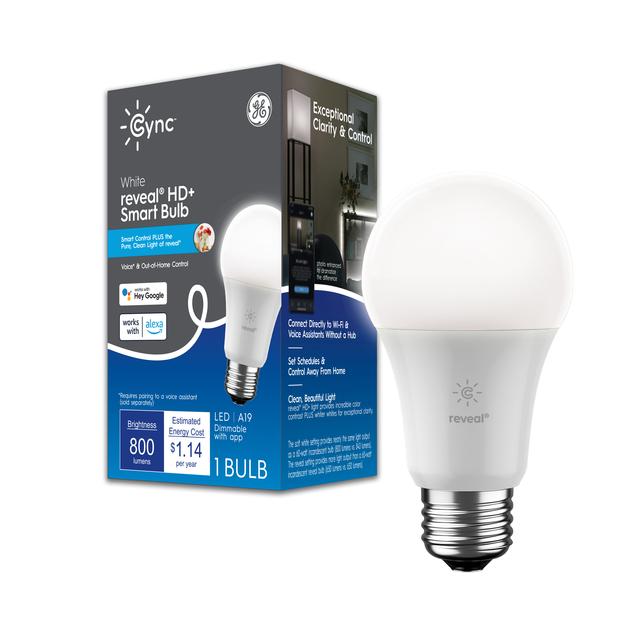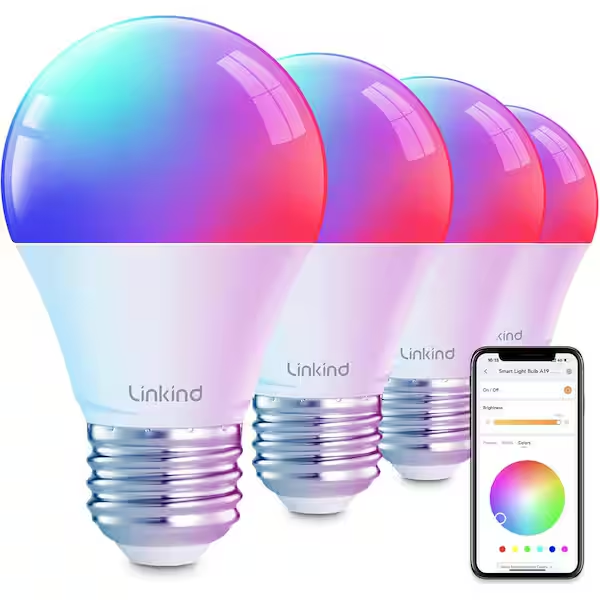The Evolution of Smart Lighting Technology
Smart lighting technology has advanced rapidly in recent years. Gone are the days when a bulb simply provided light. Today, google smart light bulbs offer a level of control and functionality that can transform how we interact with our spaces. They can adjust brightness, change color, and even sync with your daily routines.
Initially, smart bulbs were a niche luxury. Early versions required hubs and had limited features. But innovation has changed that. Now, most smart bulbs use Wi-Fi or Bluetooth, making them easier to connect and control. Some use mesh Wi-Fi networks to enhance range and connectivity, ideal for larger homes.
Modern smart bulbs such as the WiZ 60W A19 Color LED Smart Bulb are a testament to this evolution. They pair instantly with apps, bringing dynamic color changes and robust scheduling to any room. Features like a circadian-rhythm mode, which adjusts light temperature to support your sleep cycle, are becoming common.
In addition to convenience, smart bulbs now play a significant role in home security. They can simulate occupancy with scheduling, turn on when motion is detected, and integrate seamlessly with smart home ecosystems. They’re not just about lighting; they’re versatile tools that contribute to the efficiency and security of our homes.
As the trend continues, we’re seeing more sustainable options and advanced integrations. LED technology ensures energy efficiency, which is kind to your wallet and the planet. Companies are also focusing on user experience, making bulbs faster to pair and simpler to use with various platforms like Amazon Alexa, Google Home, and Apple HomeKit.

How to Select the Right Smart Bulb for Your Needs
Selecting the right smart light bulbs is key to maximizing the benefits and enjoying a better lighting experience. Whether you’re creating the perfect ambiance, improving home security, or managing energy costs, various factors should go into your choice.
Consider Brightness and Lumens
Brightness is vital when choosing a smart bulb. Check the lumens – the measure of brightness. For living rooms, choose bulbs emitting around 800 to 1,100 lumens. Bedrooms may require softer light, around 450 lumens. Some smart bulbs offer adjustable brightness, which adds versatility.
Evaluate Color Temperature and Effects
Color temperature impacts the mood of a room. Smart bulbs can range from warm (yellow tones) to cool (bluish tones) light. Some bulbs offer a full spectrum of colors, enhancing entertainment experiences or holidays.
Understanding Smart Bulb Connectivity Options
Smart bulbs can connect via Wi-Fi, Bluetooth, or mesh networks. Wi-Fi bulbs work well in most homes but require a strong signal. Mesh network bulbs maintain connection across large homes. Choose connectivity that matches your home size and router strength.
Top Smart Light Bulbs of 2024: Features and Benefits
The 2024 lineup of smart light bulbs brings enhanced features at competitive prices. Each bulb offers unique benefits, appealing to various user needs from basic lighting to advanced smart home integration.
WiZ 60W A19 Color LED Smart Bulb
The WiZ 60W A19 Color LED stands out for its bright illuminance and wide color spectrum. It links easily with Wi-Fi, allowing rapid setup via its app. Users enjoy features like scheduled lighting and dynamic scene shifts. Its circadian rhythm mode is perfect for supporting natural sleep patterns. This bulb is ideal for both its cost-effectiveness and its performance enhancements.
Meross MSL120 Smart Wi-Fi LED Bulb
Known for its robust support for Apple Home, the Meross MSL120 combines reliability with efficient smart-home integrations. Its consistent light output at various angles suits different fixture designs. Fast and efficient, its response time to smart-home commands is exceptional. A top choice for Apple users seeking a seamless smart home experience.
RCA Smart Wi-Fi A19 LED Bulb
The RCA Smart Wi-Fi A19 excels in maintaining strong light output even at low brightness, which is particularly useful for evenings. Its app provides an intuitive and uncluttered interface, making adjustments simple for any user. With features like music syncing and easy scheduling, this bulb is best for those who prefer straightforward control.
U-tec Bright A19 1100LM
For larger homes, the U-tec Bright A19 1100LM uses mesh Wi-Fi technology, ensuring strong connections across vast spaces. Its high brightness levels and effective light distribution make it perfect for wide area coverage. Even though it’s slightly pricier, its performance justifies the investment, particularly for expansive setups.
Each of these smart bulbs has been crafted to meet specific needs, highlighting thoughtful designs and user-focused functionalities. Whether optimizing for utility, compatibility, or extensive coverage, there’s a perfect smart bulb waiting to brighten your space in 2024.

Installation and Setup of Smart Light Bulbs
Installing smart light bulbs is a simple process that anyone can do. It usually involves a few straightforward steps that allow you to begin using your smart bulbs in no time. Below, we have laid out an easy-to-follow guide that will help you set up your new lighting devices effectively.
Step-by-Step Guide to Installing Smart Bulbs
- Unpack the Bulbs: Take your smart bulbs out of their packaging carefully.
- Remove Older Bulbs: Turn off your lamp or light fixture, and then unscrew any old bulbs.
- Install Smart Bulbs: Screw in your new smart bulb just like any regular bulb.
- Power On: Turn on the fixture or lamp to power the bulb for pairing.
- Download App: Get the app recommended by the bulb’s manufacturer on your smartphone.
- Connect: Open the app and follow its instructions to connect the bulb to your Wi-Fi or other networks.
- Customize Settings: Set up schedules, change colors, adjust brightness, and explore other features.
Once you complete these steps, your smart bulbs should be ready for use.
Compatibility with Smart Home Ecosystems
To get the most out of smart light bulbs, check their compatibility with your smart home systems.
- Amazon Alexa: Control your bulbs with voice commands through Alexa-supported devices.
- Apple HomeKit: Use Siri to manage your lighting if the bulbs are compatible with HomeKit.
- Google Home: Integrate bulbs with Google Home for a seamless experience across Google devices.
- Samsung SmartThings: Connect bulbs with the SmartThings app for centralized control.
Remember, compatibility varies by bulb model, so verify the smart integrations offered by the manufacturer before purchase. This ensures your smart light bulbs work smoothly within your existing smart home ecosystem.
Creative Ways to Use Smart Light Bulbs
Smart light bulbs offer endless creative possibilities. From setting the mood to managing energy use, they’re versatile and convenient.
Enhancing Home Entertainment and Ambiance
Google smart light bulbs can change your space with just a touch or a voice command. Here’s how:
- Mood Lighting: Adjust colors to suit your mood or event. Choose soft yellows for a cozy night in, or vibrant hues for a party vibe.
- Sync with Music: Some bulbs sync with your tunes, flashing colors in rhythm. Perfect for a home dance party.
- Theater Experience: Create a movie theater atmosphere. Dim lights as the film starts, just like in the cinemas.
- Gaming: Gamers can enhance their play with responsive lighting that reacts to the game’s action.
Try these ideas to make your home entertainment spots more immersive and fun.

Utilizing Schedules for Energy Efficiency
Smart bulbs can help save energy with smart scheduling. Here’s what you can do:
- Set Timers: Program your lights to turn off after you fall asleep, or when the room is not in use.
- Wake Up and Wind Down: Use warm lights to wake up gently in the morning and cool tones to stay alert during the day.
- Vacation Mode: Simulate presence at home while away. Set lights to turn on and off at random times.
- Integrate with Sensors: Connect smart bulbs with motion sensors to light up only when needed.
Google smart light bulbs are not just for convenience. They are tools for smarter energy use and lower bills.
Tips for Maintaining and Troubleshooting Smart Bulbs
Proper maintenance and knowing how to troubleshoot can extend your smart bulbs’ life and ensure their efficiency. Here are some tips to keep in mind:
Regularly Check for Updates
Smart bulbs, like other tech devices, get firmware updates. These updates can fix bugs, improve performance, or add new features. Use your bulb’s app to check for and install updates regularly.
Keep Them Clean
Dust can accumulate on bulbs, affecting their brightness and color. Gently clean the bulbs with a dry cloth to avoid buildup.
Ensure Stable Wi-Fi Connection
A stable Wi-Fi connection is crucial. If bulbs disconnect often, move your router closer or consider a mesh network for large homes.
Reset Bulbs When Necessary
If a bulb isn’t responding, try resetting it. Power it off, wait a minute, and power it back on. Check the app for reset instructions.
Monitor Overheating
If bulbs get too hot, they can fail prematurely. Make sure they’re not enclosed in small spaces and can cool down properly.
Use Within Rated Wattage
Using bulbs within their rated wattage ensures safety and longevity. Don’t use a higher wattage bulb than your fixture allows.
Seek Help for Technical Issues
If you can’t resolve an issue, contact the manufacturer’s support. They can often troubleshoot problems or offer replacements.
Remember, maintaining your smart bulbs not only helps with longevity but also with performance, ensuring they illuminate your space effectively for longer.
The Future of Smart Lighting: Trends to Watch
As smart lighting technology advances, several trends are emerging that promise to redefine our interaction with home lighting.
Greater Integration with IoT Devices
Smart lighting systems are increasingly integrating with a broader range of Internet of Things (IoT) devices. This means that your lights will not only be controllable through apps and voice commands but also interconnected with other home devices for a more holistic and intuitive home automation experience.
Enhanced Color Adjustability and Scenes
Expect to see smart bulbs with more sophisticated color adjustability. Upcoming models will likely offer expanded color palettes for more customized ambiance settings. Furthermore, these bulbs will feature enhanced scene capabilities, allowing users to create more dynamic environments that can change with moods, activities, or time of day.
Improved Energy Efficiency
Energy efficiency remains a top priority. Future smart bulbs will consume even less power while delivering higher luminosity. This advancement will not only help to reduce household energy costs but also contribute to broader environmental conservation efforts.
More Advanced Sensors
Upcoming smart light bulbs will incorporate more advanced sensors. These sensors will enable features such as adaptive brightness, where the light adjusts based on the ambient light in the room, potentially enhancing comfort and further reducing energy consumption.
Cloud-Based Controls and Customizations
Cloud-based technologies are set to revolutionize the way we interact with smart lighting. This will allow for more complex scheduling, remote access from any location, and personalized lighting experiences that can be adjusted for each user.
These trends, combined with ongoing advancements in technology, suggest a bright future for smart lighting that will continue to enhance the way we live, work, and interact with our spaces. The potential for customization and integration is vast, promising enhanced convenience and energy efficiency in our homes and beyond.